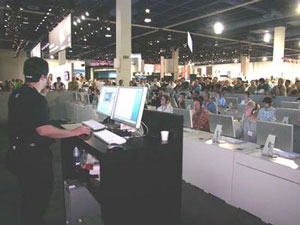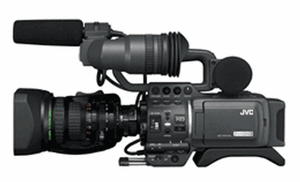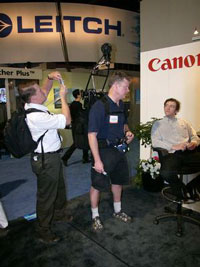 |
→ May 2005 Contents → Special Report
|
Special Report: NAB 2005
|
 |
||||||||||
|
The big story at the National Association of Broadcasters' convention in Las Vegas last month was HIGH DEFINITION. HD was everywhere. Cameras and software systems manufacturers understand that a true revolution has taken place in the industry.
Apple's Final Cut Pro 5 was far and away the hit of the show. The Apple booth drew standing-room-only crowds in the South Hall, and there were long waiting lines to get their hands on the G5 computers to try the program. "We really think 2005 is the year of HD," Rob Schoeben, Apple's Vice President of Applications Marketing, told the hundreds of international press gathered for the unveiling of the Mac OS X version 10.4, code-named "Tiger," and the new Final Cut Studio suite of applications. "At NAB 2005, we are releasing a new platform for high-definition production and playback that is affordable to the HD community," Schoeben explained. The heart of the systems is the new Quicktime 7, and the H.264 codec that allows the HD workflow to be handled at SD rates. FCP5 also features a new graphic waveform editor and an integrated multitrack mixer, and for graphics, Motion 2 features accelerated 32-bit float rendering. All this in a package that sells for $1,600.
Some of the assembled press blinked a few times when Avid unveiled its "Avid News Instinct" software, which has as its stated aim the ability to turn over the integration of news text with video footage, all from the reporter's desk. I would imagine that some editors and photojournalists might have a few qualms about this one.
Sony had already taken the HD video journalism market by storm with its introduction earlier this spring of its HVR-ZIU camcorder, (see our review by Steve Smith in the April issue of The Digital Journalist) and the HVR- M10U HD professional deck.
Panasonic's entry in the VJ HD field is its HVX-200 camcorder, which it showed "under glass" as a balsa wood model. The camera will not be in stores until the last quarter, but according to industry sources it is the one to beat. It will inherit their Varicam variable frame rate, which responds to both slow and quick action, which was introduced last year in its high-end ENG camera, the SDX800, with both 24p and 30p progressive scan video. It will have cine-like gamma curves and color matrix, like the Canon XL2. It features a native 16:9 image ratio. Controls and system interfaces are designed for the professional. It records on both 1080i and 720p in DVCPro compression. The most important feature of the camera is its P2 recording medium. Video is recorded on P2 cards as MXF files that can be instantly downloaded to a nonlinear edit system, which means the elimination of wasting time digitizing footage. At $5,900, the camera comes without the P2 cards, but for $8,000 you get two 8-gig cards. Some video journalists may find this causes an expensive storage solution, especially if projects are going to sit on the shelf for long periods of time before getting to edit.
However, with external hard drives becoming cheaper all the time, the user would normally download the video immediately after shooting, and be ready to start again.
Canon had nothing to show this time in high-end cameras. Their strategy has always been to wait and see how these technologies work out in the marketplace, and then make their move. Generally they introduce their new models in the third quarter, and all indications are that you can expect to see their next move then.
All of the big players will be after the HD market, including the biggest of them all, Verizon, which has spent more than $23 billion getting ready to deliver the signals to the viewer. This is more than all five major cable companies combined. Devices will be appearing soon that deliver video to everything from the Internet to mobile phones. Industry experts expect this market to hit an annual $600 billion a year worldwide. In the DVB Pavilion in the South Hall at NAB, manufacturers were running live end-to-end television transmission to a handheld device using its DVB-H spectrum. Several broadcast companies, including Harris Broadcast, Crown Castle Mobile Media, Nokia, Samsung, Texas Instruments and Microsoft, were demonstrating DVB-H. These small instruments will start appearing in information and entertainment, games, business-to-business services, machine-to-machine/telematics for in-car use and other TV-like subscription services for mobile phones.
© Dirck Halstead
Editor and Publisher of The Digital Journalist
|
|||||||||||
Back to May 2005 Contents
|
|




